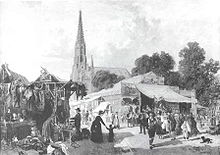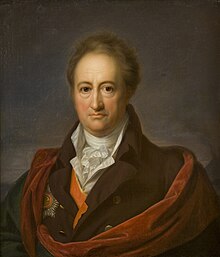Novella (Goethe)
Novelle is a prose story by Johann Wolfgang von Goethe . Conceived on March 23, 1797 as the verse epic Die Jagd , the material was not taken up again until October 1826 and January / February 1827, rewritten in prose form, "corrected and adjusted" at the beginning of 1828 and was available in print in spring 1828. Goethe himself chose the literary genre Novelle as the title of the story .
action
One autumn day the prince wants to hunt in the woods of his principality. When he says goodbye to the young wife, he recommends that she go for a ride. The princely uncle Friedrich and the court squire Honorio are supposed to escort the princess. The prince rides out of the castle with his hunting party , and the princess waves the handkerchief to her husband . Then the lady goes into a room, at the window of which the splendid telescope is aimed at the ancient, half-ruined family castle on the top of the rock , surrounded by mighty trees. The princess follows her husband's ride through the telescope and waves her handkerchief once more. The sprightly old uncle comes with a large portfolio full of drawings. He doesn't think about riding off. Wordfully, accompanied by the drawings, he explains to the Countess the restoration work of that family castle. Honorio reports that the princess's favorite horse is saddled. The princess would just like to have a look at the castle ruins, but first ride through the city, past the fair. Uncle doesn't like. He never likes to ride through the market and fair. The princess knows the story of the fire at the fair , which her uncle once narrowly escaped, and she prevails. Honorio takes the periscope . You ride down. The people, crowded together in the market, think that the first woman in the country is also the most beautiful and graceful. The three riders come to a larger wooden building in which a lion and a tiger are on display. The lion roars at feeding time , while the tiger lies quietly in its dungeon .

It is already noon when the three riders approach the destination of their pilgrimage , the mighty ruin, and from a vantage point in a mountain forest they can see both the nearby ruin and the now distant city with the princely residence. The rest of the novella takes place in the mountain forest below the castle ruins or in the castle ruins themselves. There is a cheerful silence over the landscape , as it usually is at noon. Honorio looks through the periscope at the city and has to state that the market is starting to burn . Uncle wants to go back at once. The princess and Honorio would like to slowly follow their uncle. Honorio is not in a hurry either and recommends the old man: Ride your Highness slowly, please, slowly! In the city as in the castle the fire facilities are in perfect order. The uncle leaves the scene, rides down towards the royal residence, and in his place the runaway tiger jumps up. Flee! calls Junker Honorio to the countess. She dashes away, but her horse falls. The tiger approaches the countess, but Honorio, quite chivalrous, proves himself at the climax of the novella and hits the monster in the head with the pistol . The Princess demands of Honorio: Give him the rest. But the tiger is already dead.
Then the owner of the beast of prey, the operator of a traveling menagerie, and identified by the neatly decent but colorful and strange clothes : a guard , the showman's wife , and a boy who holds a flute in his hand . The guard laments the murder of the tiger without need . The prince's hunting party rides up, and the prince stands before the strange, outrageous event. Now the boy's father, dressed in brightly colored and whimsical clothes , comes up to the prince and announces the next unheard of event: the lion is also gone . It turns out that the big cat has been sleeping in the sunshine up in the castle ruins for some time . The boy's father asks the prince to catch the big animal in his own way. He wants to bring up the steamed-up box , and the boy should first appease the predator by playing the flute. Then it should be lured into its dungeon. The militarily experienced prince remains in control of the situation. He looks down at his wife, who, leaning against him , pulls out the handkerchief and covers her eyes with it. The prince allows the strange lion-catching method, gives Honorio appropriate orders for the strange situation and leaves the scene with the princess. The gentlemen ride down with the hunting party in the direction of the princely residence. Honorio remains armed on guard in the rocky forest, as ordered. The boy climbs up to the ruin and soothes the lion, alternately playing the flute and singing the novel's message of peace :
- Lions should become lambs ...
- Bare sword freezes in the blow, ...
The lion is used to his swept dungeon floor. In the “wilderness” of the Principality, a sharp thorn branch stuck between the balls of the feet. The soothed lion approaches the boy with some complaint , lays his heavy right front paw on his lap and allows himself to be treated. Then the boy flutes and sings:
- And so goes with good children
- Selger Engel likes to advise
- To prevent evil will
- Nice deed to promote.
Honorio, the only person who stayed at or near the scene of the action consistently, can smile and let the rifle rest in his lap.
Explanations
To the idea of the story
In a conversation with Johann Peter Eckermann, Goethe himself compared the story to a “plant that for a while sprouts strong green leaves to the sides from a strong stalk and finally ends with a flower. The flower was unexpected, surprising, but it had to come; yes, the green foliage was only there for her and would not have bothered her without her. ”According to Eckermann, he continued to interpret this comparison and the story itself:
“It was the task of this novella to show how the irrepressible, insurmountable is often better conquered by love and piety than by violence, and this beautiful goal, which is represented in the Child and Leo, stimulated me to carry it out. This is the ideal, this is the flower. And the green foliage of the real exposition is only there for this reason and is only worth something for this reason. Because what is the real in itself? We enjoy it when it is presented with truth, yes, it can also give us a clearer knowledge of certain things; but the real gain for our higher nature lies only in the ideal that emerged from the heart of the poet. "
To the title
Eckermann discussed several suggestions for a title with the poet, no one wanted to fit the whole:
“'You know what,' said Goethe, 'we want to call it the' novella '; for what is a novella but an unheard-of occurrence. This is the actual term, and so much of what goes under the title novella in Germany is not a novella at all, but just a narrative or whatever you want. In that original sense of an unheard-of incident, the novella also appears in the ‹ Elective Affinities ›. '"
The characterization of the novella as an unheard-of occurrence became famous and can be found in most German-language attempts to define this genre.
Further statements by Goethe on the novella
“But one thing has to be done in the exposition. The lion must roar when the princess rides past the booth; and I can have some good reflections made on the fearfulness of the huge animal. "
“However, it gives me the most pleasant feeling that the 'novella' is received in a friendly manner; you can feel that she has detached herself from the deepest depths of my being. The conception is over thirty years old. "
Radio play editing
- 1953: Radio play with Oskar Werner (reader), Otto Collin (Prince), Käthe Gold (Princess), Erik Schumann (Honorio), Willy Birgel (Prince Oheim), Therese Giehse (The Mother), Arthur Mentz (The Father), Rüdiger Schulzki (The Child) u. a. Composition: Karl Sczuka , arrangement and direction: Max Ophüls , production: SWF / BR / RB . CD: Der Hörverlag, Munich 2007 ISBN 9783899409109 .
reception
- According to Wilpert , Goethe tells a distant and highly symbolic story.
- In 1937, Gottfried Benn made fun of the novella in the story Weinhaus Wolf : "... the lions are loose - and everything runs smoothly ... today the tigers bit."
- Schulz emphasizes the poetic character of the novel . Your Pauline message is: Man works in the image of God.
- According to Schulz, the “atmosphere is stylized”, and Conrady brings up the structure of the novella by describing it as “prose of the most precise calculation”. Of course, Conrady also points out that Goethe speaks to us in symbols in his late novella .
- Hannelore Schlaffer makes fun of the text in the “Anti-Novelle” chapter of her book on novella theory. The figures shone through a complete lack of vice and are therefore useful examples of the author's thesis of renunciation.
literature
- source
- Johann Wolfgang von Goethe: Poetic Works, Volume 6 . Pp. 431-452. Phaidon Verlag Essen 1999, ISBN 3-89350-448-6 .
- Secondary literature
- Rolf Füllmann: 'Goethe: Novelle'. Interpretation. In: Rolf Füllmann: Introduction to the novella. Annotated bibliography and person index. Wbg (Scientific Book Society), pp. 100-109. Darmstadt 2010, ISBN 978-3-534-21599-7 .
- Gerhard Schulz : The German literature between the French Revolution and the restoration. Part 2. The Age of the Napoleonic Wars and the Restoration: 1806–1830. Pp. 334-339. Munich 1989, ISBN 3-406-09399-X .
- Hannelore Schlaffer : Poetics of the Novella. Metzler, Stuttgart 1993, ISBN 3-476-00957-2 .
- Gero von Wilpert : Goethe-Lexikon (= Kröner's pocket edition . Volume 407). Kröner, Stuttgart 1998, ISBN 3-520-40701-9 , pp. 775-776.
- Karl Otto Conrady : Goethe - life and work. Pp. 978-982. Düsseldorf and Zurich 1999, ISBN 3-538-06638-8 .
Web links
- Amendment to Project Gutenberg ( currently usually not available for users from Germany )
- Novella in the Gutenberg-DE project
- The text at Zeno.org
- Discussion in goethezeitportal.de
- Discussion in zum.de
- Discussion in Wissen-im-netz.info/literatur
- Readers' reviews in the community ciao.de
- free audio book, read by Michael Schrodt - at vorleser.net
- Read by Hans-Jürgen Schatz
Individual evidence
- ↑ Conversation from January 18, 1827, quoted from Goethe's works , ed. by Erich Trunz , Wegner Verlag, Hamburg 1960, Vol. VI, p. 725.
- ↑ Conversation from January 29, 1827, quoted from Goethe's works , ed. by Erich Trunz , Wegner Verlag, Hamburg 1960, Vol. VI, p. 726.
- ↑ Review note on audio book Novelle in Perlentaucher
- ↑ Wilpert p. 775, 24. Zvo
- ↑ Gottfried Benn, quoted in Conrady p. 982, 10th Zvu from
- ↑ Schulz p. 339, 5. Zvo
- ↑ Schulz p. 334, 5th Zvu
- ↑ Conrady p. 979, 12. Zvo
- ^ Conrady p. 981
- ↑ Hannelore Schlaffer, p. 273, 5th Zvu
